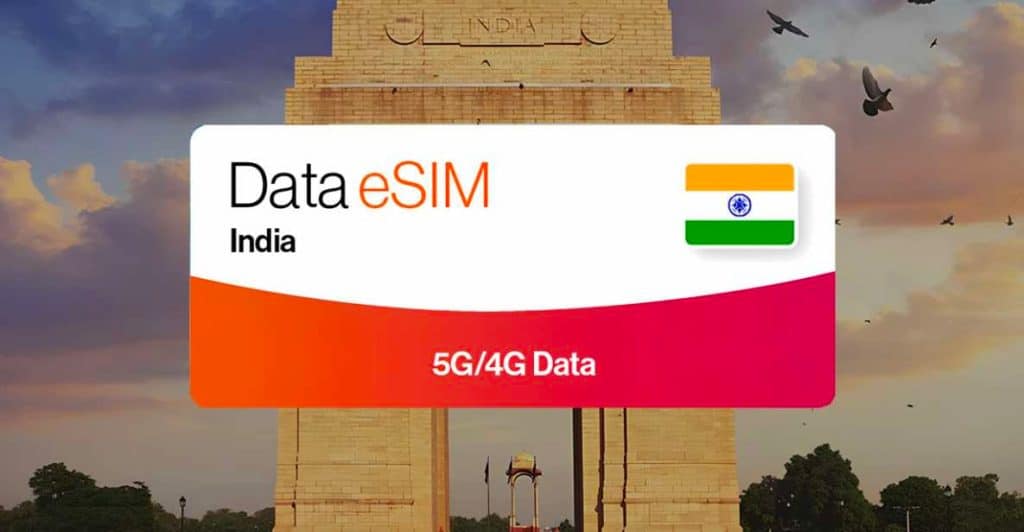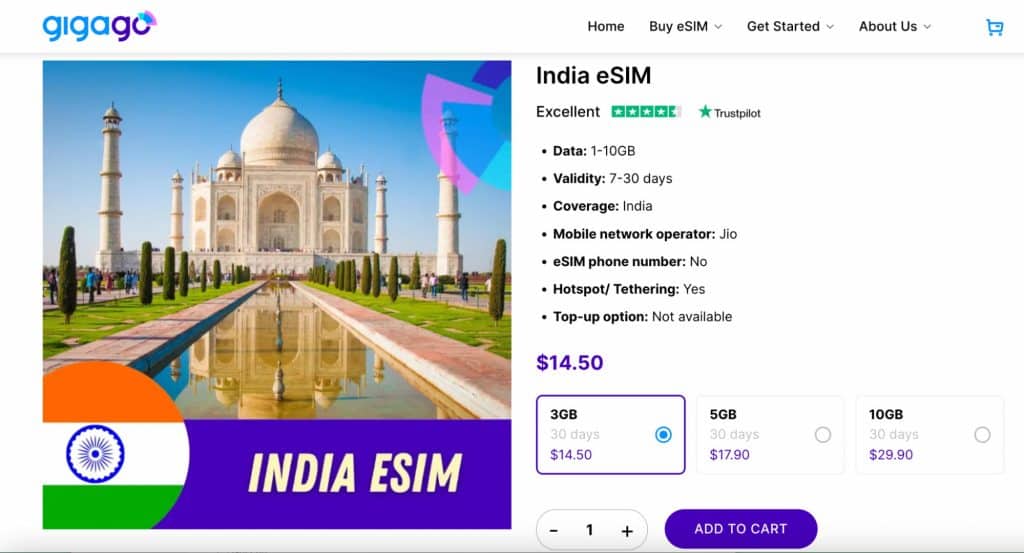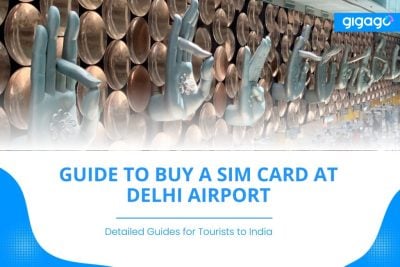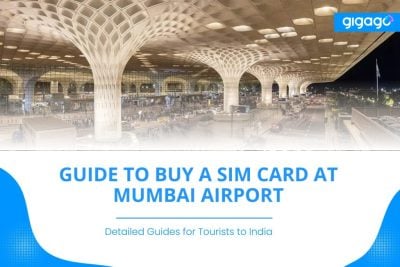This guide provides information on different WiFi options, safety tips, and where to find charging stations throughout the airport.
Use Cell Phone In India for Tourists 2024: How To Do It?
Traveling to India this year and wondering how you can use cell phone in India during your trip? This guide covers everything you need to know about using your phone in India. It includes phone compatibility, local frequencies and networks, international plans, and your options for getting connected. We’ll explore the top considerations for how to use cell phone in India as a tourist and have you calling, texting, and using data in no time.

In this article
I. Highlights of Phone Compatibility, Frequencies, and Networks in India
To have a smooth Internet connection in India, you must understand the compatibility of your phone, the frequencies used, and the networks available in the country.
1. Phone Compatibility
When you visit India, it’s important to check if your phone will work there. Here are a few things to consider:
- Make sure your phone works with the networks in India (like GSM bands 900 MHz and 1800 MHz for 2G).
- Your phone should be unlocked to use India SIM cards.
- Having a phone with dual-SIM capability can be useful. You can keep your number and use a local SIM for data and calls.
- Check if your phone supports VoLTE for better call quality on 4G networks.
- Using a smartphone lets you access apps for navigation, ride-sharing, and translations to make your time in India better.
2. Frequencies Used in India
- 2G Networks: Primarily operate on 900 MHz and 1800 MHz frequencies.
- 3G Networks: Utilize the 2100 MHz frequency band.
- 4G LTE Networks: Use bands such as 850 MHz (band 5), 1800 MHz (band 3), and 2300 MHz (band 40).
- 5G Networks: Expected to leverage higher frequency bands like 3300 MHz to 3600 MHz (yet to be fully operational nationwide).
So, make sure that your phone are supported with frequencies used in India.
3. Networks Available
Major mobile network operators in India include Reliance Jio, Airtel, Vodafone Idea (Vi), and BSNL/MTNL.
- Reliance Jio operates exclusively on an LTE network and is known for its all-IP data strong network with voice-over-LTE (VoLTE) support.
- Airtel and Vi provide extensive 2G, 3G, and 4G LTE coverage, and are actively preparing for 5G networks.
- State-run operators BSNL and MTNL offer wider 2G and 3G coverage, with plans to upgrade to 4G and future 5G services.
If you travel to popular destinations in India, choosing one of these network carriers is equally good.
For most coverage across India, get a SIM card covered by Airtel or Vi. Both have widespread 4G networks suitable for calling and data. Jio only works on newer phones with VoLTE support.
II. Use cell phone in India – Will My Phone Work?

Yes, chances are, your cell phone may work in India, but certain requirements must be met for successful operation:
- Your phone must be compatible with the GSM bands and frequencies used in India.
- Your phone should be unlocked, allowing you to use SIM cards from local Indian carriers.
- Ensure it supports VoLTE for improved call quality on 4G networks.
Compatibility with networks like Reliance Jio, Airtel, Vodafone Idea (Vi), and BSNL/MTNL heavily depends on whether your phone supports the specific bands these carriers operate on.
As you prepare for your trip, it’s crucial to check with your device’s manufacturer or your mobile carrier to confirm network compatibility. The table below about India’s mobile network carrier bands and frequencies will help you a lot:
India’s Mobile Network Carrier Bands and Frequencies
| Carrier | 2G | 3G | 4G | 5G |
| Airtel | GSM 900/1800 MHz | UMTS 2100 MHz | LTE 1800/2300/700/800 MHz | NSA: n1/n3/n28/n78 |
| Jio | GSM 900/1800 MHz | UMTS 2100 MHz | LTE 1800/2300/800 MHz | NSA: n41/n78 |
| Vi | GSM 900/1800 MHz | UMTS 2100 MHz | LTE 1800/2300/800 MHz | NSA: n1/n3/n28/n78 |
| BSNL | GSM 900/1800 MHz | UMTS 2100 MHz | LTE 1800/2300 MHz | NSA: n1/n3 |
| MTNL | GSM 900/1800 MHz | UMTS 2100 MHz | LTE 1800/2300 MHz | NSA: n3 |
This table represents the general bands and frequencies used by each carrier. Coverage and specific frequencies may vary in different regions.
III. Do I Need An International Plan In India?

Traveling to India, you are advised to acquire an international SIM plan for India. This is different from local SIM plans. Below are some noticeable reasons:
- avoid expensive roaming fees
- maintain home phone number while being abroad
- seamless coverage across the country
- various options of SIM plans to choose from that fit your needs and travel duration
Why you can use free WiFi while traveling India, it comes with some disadvantages like:
- Limited Availability: Free WiFi may be unreliable or unavailable outside major cities or tourist spots.
- Security Risks: Open networks can pose significant threats to data privacy, making them susceptible to hacking and cyber threats.
- Inconvenience: Seeking out WiFi hotspots can be time-consuming and inconvenient.
- Lower Speeds: Public WiFi networks can be slower when many people are using the same hotspot.
So an international plan can help you avoid these issues and make your stay in India more comfortable and connected.
IV. What Are Options To Use Cellphones In India For Tourists?
Tourists can stay connected while traveling in India with prepaid eSIMs, international SIM cards, and pocket WiFi. These services offer plans with cellular data, phone calls, and messaging. Let’s discover their features and where to purchase them.
1. eSIM Plan for India

eSIM is a virtual/digital SIM card embedded into the device’s motherboard and allows you to get a mobile plan from a local carrier without having to swap a physical SIM card.
- Suitable For: Convenient cellular service for travelers with newer devices.
- Where To Buy: Online or carrier’s app; arrange before travel or at major airports.
- Pros: No physical SIM needed; pre-select and install plans before arrival; environmentally friendly.
- Cons: Limited to newer, eSIM-compatible devices; not supported by all operators; potentially challenging setup for non-tech-savvy individuals.
Note: To use eSIMs while traveling abroad, your phone must be carrier-unlocked and eSIM-compatible.
2. International SIM card for India

For travelers who prefer traditional means of connectivity, an international SIM card is an excellent choice for staying in touch while in India. These SIM cards can be readily purchased and offer a range of plans tailored to tourists’ needs. Consider the following when opting for an international SIM card:
- Suitable For: Tourists needing immediate connectivity and mobility across India.
- Where To Buy: Airport kiosks, mobile stores, or online before travel.
- Pros: Multi-country usage, flexible plans, avoid eSIM setup.
- Cons: Requires unlocked SIM slot, potentially higher costs, physical card inconvenience, and.
3. Pocket WiFi

Pocket WiFi devices are yet another solution for tourists seeking internet connectivity in India. These portable gadgets provide a personal and secure hotspot that connects multiple devices to the internet. Below are the details for considering a Pocket WiFi for your travels:
- Suitable For: Tourists in groups or with multiple devices; needing constant internet.
- Where To Buy: Online or at airport kiosks in India.
- Pros: Single device for multiple gadgets; pay for usage without changing SIM; no compatibility concerns.
- Cons: Extra items to carry and charge; costly for long-term use; dependent on coverage area.
V. Will My Local Network Work In India?
Most likely possible. However, using your home network for India travel can be very expensive due to high roaming fees. While it is convenient for users, roaming charges for are applied for every l calls, texts or data can accumulate quickly.
Therefore, it is NOT RECOMMENDED TO USE your primary home SIM card with your local network carrier for India travel.
Instead, choose to use International SIM cards or eSIMs which use the Indian domestic networks. This way, you still stay connected while saving money during your trip.
Advice: Always explore and compare the costs and benefits of all connectivity options before you travel. In most scenarios, purchasing a local eSIM plan, international SIM card, or renting a Pocket WiFi will be more economical and practical for your trip to India.
VI. Gigago eSIM – An Alternative To Get Internet In India With Your Cell Phone

Gigago eSIM stands out as a premier choice for travelers seeking a hassle-free way to stay connected in India. using eSIM from Gigago, it is no need to visit a store upon arrival; instead, tourists can arrange their eSIM plans online, selecting from a variety of diversified plans to suit their travel needs and budget.
Which Indian eSIM plan should you choose for your trip?
For India, Gigago offers multiple data plan options, starting from 3 GB for 30 days with $ 2.5 . So, tourists can consider some options eSIM plans by Gigago which is appropriate with their trip. Thus, it does not matter how Internet users you are and how long your trip is in India, there is always an option for you with Gigago.
VII. Extra Tips To Use Cell Phone in India
Before setting out on your Indian adventure, it’s crucial to be savvy about mobile usage to avoid any hitches in communication. Here are additional tips to ensure that your cellphone experience in India is as smooth and trouble-free as possible.
- Check Compatibility: Ensure your device is compatible with India’s cellular frequencies.
- Keep Chargers Ready: Carry a universal travel adapter for India’s power sockets.
- Save Important Contacts: Pre-save local emergency numbers in your phone.
- Monitor Data Usage: Use apps to track your data consumption and avoid overages.
- Backup Your Data: Regularly backup your phone’s data in case of theft or loss.
- Be App Savvy: Download essential apps for navigation, translation, and ride services.
- Stay Secure: Use VPN services for an added layer of security while on public networks.
- Respect Privacy: Be mindful of photographing people or sensitive locations without permission.
VIII. FAQs about Use Cell Phone in India
Can I use my current phone number with an eSIM while traveling in India?
Yes, you can maintain your current phone number when using an eSIM. Although you’ll have a new local number provided by the eSIM, services like call forwarding can help you receive calls made to your regular number.
What should I do if I lose my phone while having an eSIM or international SIM in India?
Immediately report the loss to the eSIM provider or international SIM card operator to prevent unauthorized usage. It is also advisable to remotely wipe your phone’s data if possible and notify local authorities of the loss.
Are there any restrictions on using streaming services with my eSIM while in India?
No, there are no restrictions on using streaming services with your eSIM while in India. However, it is essential to keep track of your data usage to avoid overages and additional charges. It is also advisable to check if the streaming service you plan on using is available in India before your trip.
IX. Conclusion
Use cell phone in India is not a complicated thing. By choosing an eSIM, international SIM card, or Pocket WiFi, you can stay connected affordably and conveniently throughout your travels.
Remember to compare plans, monitor usage, and prioritize security to enhance your stay. With these tools and tips, your journey through India will not only be enriched but also seamlessly connected.





